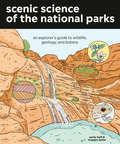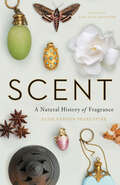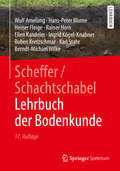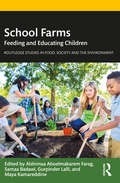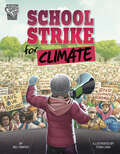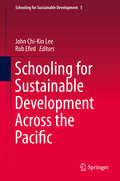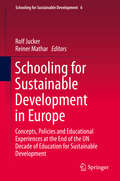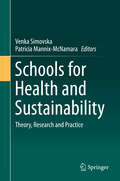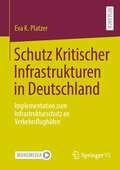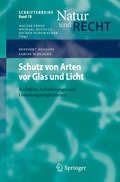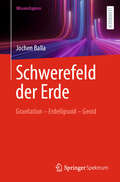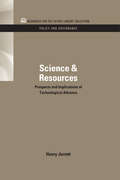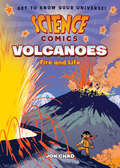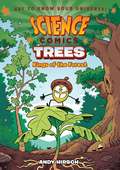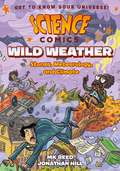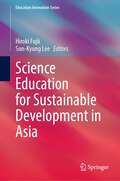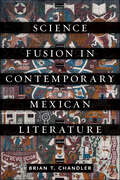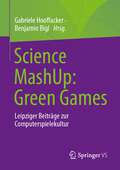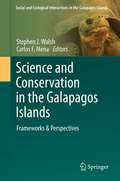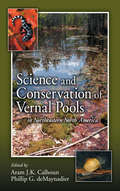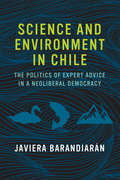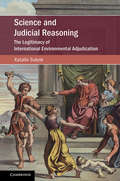- Table View
- List View
Scenic Science of the National Parks: An Explorer's Guide to Wildlife, Geology, and Botany
by Emily Hoff Maygen KellerExplore the fascinating science behind the national parks in this charming illustrated guide. The national parks are some of the most beloved, visited, and biodiverse places on Earth. They're also scientific playgrounds where you can learn about plants, animals, and our planet's coolest geological features firsthand. Scenic Science of the National Parks curates and breaks down the compelling and offbeat natural science highlights of each park, from volcanic activity, glaciers, and coral reefs to ancient redwood groves, herds of bison, giant bats, and beyond. Featuring full-color illustrations, information on the history and notable features of each park, and insider tips on how to get the most out of your visit, this delightful book is the perfect addition to any park lover's collection.
Scent: A Natural History of Fragrance
by Elise Vernon PearlstineA fascinating exploration of the natural history of scent and human perceptions of fragrance from the viewpoint of plant and pollinator &“An evocative journey that awakens one&’s curiosity to an oft-forgotten sense.&”—Dana Dunham, Scientific American Plants have long harnessed the chemical characteristics of aromatic compounds to shape the world around them. Frankincense resin from the genus Boswellia seals injured tissues and protects trees from invading pathogens. Jasmine produces a molecule called linalool that attracts pollinating moths with its flowery scent. Tobacco uses a similarly sweet-smelling compound called benzyl acetone to attract pollinators. Only recently in the evolutionary history of plants, however, have humans learned to co-opt their fragrances to seduce, heal, protect, and alter moods themselves. In this wide-ranging and accessible new book, biologist-turned-perfumer Elise Vernon Pearlstine turns our human-centered perception of fragrance on its head and investigates plants' evolutionary reasons for creating aromatic molecules. Delving into themes of spirituality, wealth, power, addiction, royalty, fantasy, and more, Pearlstine uncovers the natural history of aromatic substances and their intersection with human culture and civilization.
Scheffer/Schachtschabel Lehrbuch der Bodenkunde: Lehrbuch Der Bodenkunde
by Karl Stahr Hans-Peter Blume Heiner Fleige Rainer Horn Ellen Kandeler Ingrid Kögel-Knabner Ruben Kretzschmar Wulf Amelung Berndt-Michael WilkeDie 17. Auflage dieses renommierten Lehrbuches vermittelt ein umfassendes Wissen über Böden und deren Schutz. Böden bilden eine der wichtigsten Grundlagen für das terrestrische Leben. Für einen effektiven Schutz und Erhalt dieses Lebensraums braucht es ein grundlegendes Verständnis der Prozesse, die Böden formen, sowie der Eigenschaften der Böden selbst. Dieses Buch fasst den neusten Kenntnisstand der Forschung zusammen und vermittelt ein umfassendes Wissen der Bodenkunde. Im Detail werden behandelt: die Vorgänge der Bodenbildung und -entwicklung,die physikalischen, chemischen und biologischen Eigenschaften und Prozesse, Nähr- und Schadstoffe,die verschiedenen Bodensystematiken, die wichtigsten Böden und Bodenlandschaften,die Nutzungsbewertung der Böden, Grundsätze des Bodenschutzes. Die 17. Auflage wurde überarbeitet und ergänzt. Neu ist ein Kapitel zu Nanopartikeln als Schadstoffe im Boden. Durch seine Ausführlichkeit ist dieses Buch ein Must-Have für alle, die sich mit Böden befassen.
Schleiermacher and Sustainability: A Theology For Ecological Living
by Shelli PoeSince the 1960s, theologians have been involved in efforts to guide Christians to reflection and action in light of planetary peril. The contributors to this volume illustrate how Friedrich Schleiermacher's theological work could fulfill that need. Schleiermacher's theology, they contend, finds its culmination in Christian social action and is remarkably conducive to ecological thinking in the modern world. <P><P> Each chapter deals with a particular locus in Schleiermacher's systematic theology, focusing on its implications for sustainable living. In so doing, Schleiermacher and Sustainability offers a sophisticated account of Schleiermacher's thought that will upend many estimations of his value for current constructive theology and provide a potent resource for those seeking to integrate ecological living into the marrow of their daily existence.
School Farms: Feeding and Educating Children (Routledge Studies in Food, Society and the Environment)
by Alshimaa Aboelmakarem Farag, Samaa Badawi, Gurpinder Lalli, and Maya KamareddineThis book highlights the potential of school farms to fight hunger and malnutrition by providing access to locally produced, fresh, and healthy food as well as providing young students with educational opportunities to learn, interact with nature, and develop their skills. Hunger is one of the most pressing concerns we face today and there is a clear need to provide alternative sources of food to feed a fast-growing population. School farms offer a sustainable opportunity to produce food locally in order to feed underprivileged students who rely on school meals as an integral part of their daily diet. Approaching the concept of school farms through four themes, Problem, People, Process, and Place, the book shows how they can play an essential role in providing sustainable and healthy food for students, the critical role educational institutions can play in promoting this process, and the positive impact hands-on farming can have on students' mental and physical wellbeing. Utilizing the authors' personal hands-on experiences, and drawing on global case studies, the book provides a theoretical framework and practical guidance to help with the establishment of school farms and community-based gardening projects and an education system which promotes a sustainable and healthy approach to food, agriculture, and the environment. This book will be essential reading for students and scholars of food security, agriculture, healthy and sustainable diets, education for sustainable development, and urban studies. It will also be of great interest to practitioners and policymakers involved in food policy, developing school and community projects, global health and international development, as well as education professionals.
School Strike for Climate (Movements and Resistance)
by Nel YomtovIn August 2018, a teenager named Greta Thunberg missed school to sit outside the Swedish parliament with a sign that read School Strike for Climate. She was demanding that government leaders take stronger action against climate change due to global warming. At first, Greta sat alone. But her message spread. Other students joined her in the movement that became known as Fridays for Future. By September 2019, millions of activists from around the world marched in protests to protect the future of the planet.
Schooling for Sustainable Development Across the Pacific
by John Chi-Kin Lee Rob EfirdEnvironmental education (EE) and education for sustainable development (ESD) are asserting their growing role in curricula around the world, yet how deeply embedded are they in the learning systems of the Pacific nations? Building on an earlier analysis in China and Taiwan, this volume expands its purview to examine the quality and extent of environmental and sustainable development education in a number of countries in the Asia-Pacific region, including China itself, Taiwan, South Korea, Japan and Indonesia As well as offering detailed national analyses provided by Asian-Pacific academics and professionals, this work includes examples in the US and Canada and an introduction that assesses the contrasting challenges and positive commonalities among diverse education systems. The chapters reflect leading-edge practice, innovation, and depth of experience and at the same time as detailing locally relevant and culturally appropriate strategies they also provide clear models and strategies for expanding the application and influence of education for sustainable development elsewhere. In doing so, they mirror the global nature of environmental issues as well as the local nature of the solutions.
Schooling for Sustainable Development in Europe
by Rolf Jucker Reiner MatharThis book examines the implementation of Education for Sustainable Development (ESD) programs in schools across Europe. It describes and analyzes how individual countries and the region as a whole have established teaching and learning methods to help students develop the competencies needed to be part of a sustainable society. Featuring chapters written by experts throughout Europe, the book first provides a general overview of ESD in various contexts, including the state-of-the-art of ESD theory and conceptual development; political and social analysis; the various concepts of ESD competencies; and teacher training. Next, the book details how ESD has been implemented in different European countries and regions, including: Sweden, Italy, Germany, Austria, Switzerland, Catalonia, Hungary, Finland, Norway, Denmark, Flanders, France, Cyprus, UK and the Netherlands. In recognition of education as a motor of change, the United Nations General Assembly declared a Decade of Education for Sustainable Development (2005-2014), calling for the integration of sustainable development into all aspects of education and learning. Inside this book, readers will find details on what has been done, as well as assessments of what more could be done, across Europe. It will help readers gain valuable insights into how to help students develop the knowledge, skills and values needed to shape a sustainable future.
Schools for Health and Sustainability
by Venka Simovska Patricia Mannix McnamaraSchools are unique places. They pay a central role in the formation of young people. The importance of how young people are educated and how they are encouraged to live and learn cannot be underestimated. This book advocates for the fostering of agency not only amongst school personnel but also amongst younger generations for health and sustainability. It provides the reader with a new lens with which to discover health promoting schools and education for sustainable development. It invites the reader to look more deeply into both and to accompany the authors on a journey of discovery of the real potential for each to enhance the practice of schooling.
Schutz Kritischer Infrastrukturen in Deutschland: Implementation zum Infrastrukturschutz an Verkehrsflughäfen
by Eva K. PlatzerDer Schutz von kritischen Infrastrukturen spielt eine entscheidende Rolle bei der Aufrechterhaltung täglicher Dienstleistungen und schützt sowohl die Bevölkerung als auch die nationale Wirtschaft eines Landes. Bisher ist die Policy zum Schutz Kritischer Infrastrukturen freiwillig. Ihre Implementation hängt vom Betreiber der Kritischen Infrastruktur ab. Im Zuge der Corona-Pandemie wurden Maßnahmen ergriffen, die zu Veränderungen der Policy-Inhalte geführt haben. Zudem führt das (aktuell im Entwurf befindliche) KRITIS-Dachgesetz zu einer grundlegenden Novellierung der Policy. Dies macht eine eingehende Analyse des Status quo der Implementation durch die Betreiber erforderlich. Die qualitative Untersuchung dieser Arbeit vergleicht anhand von drei Fallstudien die Umsetzung der Policy zum Schutz Kritischer Infrastrukturen an deutschen Verkehrsflughäfen. Die Kernfragen sind dabei: Wie wird die Policy implementiert und wie lässt sich dies erklären?
Schutz von Arten vor Glas und Licht: Rechtliche Anforderungen und Gestaltungsmöglichkeiten (Schriftenreihe Natur und Recht)
by Benedikt Huggins Sabine SchlackeDieses Buch enthält eine umfassende Analyse der rechtlichen Pflichten und Gestaltungsmöglichkeiten zum Schutz vor Risiken und Gefahren für Vögel, Fledermäuse und Insekten durch Glas und Licht. Die Anlockwirkung von nächtlichen Lichtquellen auf Insekten sowie die Kollisionen von Vögeln mit Glas sind allgemein bekannt, aber bislang kaum untersucht worden. Aufgrund neuer Forschungserkenntnisse rückt die Verwendung von Glas und Licht nun stärker in den Fokus des Interesses. Diese rechtstatsächlichen Erkenntnisse werden zusammengefasst und erstmals einer umfassenden systematischen Analyse unterzogen. Das Buch arbeitet die Anforderungen des geltenden Rechts an den Schutz vor Risiken und Gefahren für Vögel, Fledermäuse und Insekten durch Glas und Licht heraus. Im Mittelpunkt steht dabei die Untersuchung der naturschutzrechtlichen Eingriffsregelung, des FFH-Rechts und des besonderen Artenschutzrechts. Das Buch entwickelt Kriterien, anhand derer sich die Erheblichkeit von Beeinträchtigungen von und Eingriffen in Natur und Landschaft bestimmen lassen, und wertet die von der Rechtsprechung zum besonderen Artenschutzrecht entwickelten Signifikanzkriterien für nachteilige Auswirkungen von Glas und Licht aus. Ein weiterer Schwerpunkt sind die baurechtlichen Gestaltungsmöglichkeiten und Vermeidungspflichten der Kommune durch Festsetzungen in Bebauungsplänen. Daneben untersucht das Buch die immissionsschutzrechtlichen Betreiberpflichten zum Schutz vor Lichtanlagen. Im Zusammenhang mit Licht wird der immissionsschutzrechtliche Begriff des Standes der Technik von Vermeidungsmaßnahmen konkretisiert und die Verkehrssicherungspflichten von Kommunen zur Beleuchtung der öffentlichen Straßen und Wege bestimmt. Schließlich wird auch die Vereinbarkeit von Skybeamern mit Bauordnungs- und Naturschutzrecht geprüft.
Schwerefeld der Erde: Gravitation - Erdellipsoid - Geoid
by Jochen BallaFür die Fallbeschleunigung ist der Wert von 9.81 m/s² allgemein bekannt. Wer über diesen Durchschnittswert hinaus die Unterschiede im Schwerefeld der Erde verstehen möchte – welches im Bereich von 9.78 m/s² bis 9.83 m/s² variiert –, muss sich mit der Gravitation des ellipsoidischen Erdkörpers auseinandersetzen. Genau das ist das Thema dieses Buchs. Es erklärt die notwendigen Begriffe und Konzepte, um über das einfache Modell einer kugelförmigen Erde hinauszugehen. Dabei werden auch die physikalischen und mathematischen Grundlagen vermittelt, sodass die Lektüre ohne spezielle Vorkenntnisse aus der Potenzialtheorie möglich ist. Das Buch richtet sich an Studierende der Physik, Geophysik, Geodäsie, Ozeanographie und verwandter Fachgebiete, die eine präzise Kenntnis des Erdschwerefelds benötigen. Sein Inhalt in Schlagworten: • Physikalische Grundlagen • Gravitationsgesetz und Potenzial • Gravitation und Schwerefeld des ellipsoidischen Erdkörpers • Niveauellipsoid und Normalschwere • Gezeiten • Geoid, Quasigeoid und Höhen. Die Produktfamilie WissensExpress bietet Ihnen Lehr- und Lernbücher in kompakter Form. Die Bücher liefern schnell und verständlich fundiertes Wissen.
Science & Life Issues: Ecology and Evolution
by University of California at Berkeley Lawrence Hall of ScienceScience and Life Issues, or SALI, uses several kinds of activities to teach science. For example, you will design and conduct an experiment to investigate human responses. You will explore a model of how species compete for food. And you will play the roles of scientists learning about the causes of infectious disease. A combination of experiments, readings, models, debates, role plays, and projects will help you uncover the nature of science and the relevance of science to your interests.
Science & Resources: Prospects and Implications of Technological Advance (RFF Policy and Governance Set)
by Henry JarrettFirst Published in 2011. Routledge is an imprint of Taylor & Francis, an informa company.
Science Comics: Fire and Life (Science Comics)
by Jon ChadGet ready to explore the depths of the ocean, the farthest reaches of space, and everything in between! Volcanic eruptions, vampire bats, feathered velociraptors, and more await you in SCIENCE COMICS. In a not-so-distant future our world is as cold as a frozen burrito. But can humanity save itself by harnessing a power that dwells inside the Earth? Explode into the world of geology in Volcanoes: Fire and Life! A lot of magic happens under the Earth's crust. Thanks to magma vents, shifting continental plates, and volcanic eruptions, we know that our planet is alive and in motion. Alongside Aurora, a young explorer, you'll learn that volcanoes are just one of the massively powerful forces at work on our planet. From catastrophic destruction to the creation of new land masses, volcanoes have made their mark on our amazing Earth.
Science Comics: Kings of the Forest (Science Comics)
by Andy HirschEvery volume of Science Comics offers a complete introduction to a particular topic—dinosaurs, coral reefs, the solar system, volcanoes, bats, flying machines, and many more. These gorgeously illustrated graphic novels offer wildly entertaining views of their subjects. Whether you're a fourth grader doing a natural science unit at school or a thirty-year-old with a secret passion for airplanes, these books are for you!In Trees: Kings of the Forest we follow an acorn as it learns about its future as Earth's largest, longest-living plant. Starting with the seed's germination, we learn about each stage until the tree's maturation, different types of trees, and the roles trees take on in our ecosystem.
Science Comics: Storms, Meteorology, and Climate (Science Comics)
by MK ReedFurious floods, looming landslides, terrifying tornadoes, ferocious forest fires! Is Mother Nature trying to tell us something? As “snowpocalypse” descends once again, one temperamental weatherman is determined to set the record straight on the myths and misconceptions surrounding the elements. What is the difference between weather and climate? How do weather satellites predict the future? Can someone outrun a tornado? Does the rotation of the Earth affect wind currents? And does meteorology have anything to do with meteors? Stormin’ Norman Weatherby is gearing up to answer all your wildest questions! Get ready to explore the depths of the ocean, the farthest reaches of space, and everything in between! These gorgeously illustrated graphic novels offer wildly entertaining views of their subjects. Whether you're a fourth grader doing a natural science unit at school or a thirty-year-old with a secret passion for airplanes, Science Comics is for you!
Science Education for Sustainable Development in Asia (Education Innovation Series)
by Hiroki Fujii Sun-Kyung LeeThis book presents an Asian perspective on transformative science education in the context of the United Nations' Sustainable Development Goals (SDGs). The chapters are written by contributors who practiced science education for sustainability in a research project entitled “Teacher Education for ESD in the Asia-Pacific Region” from 2017 to 2019, supported by the Japan Society for the Promotion of Science, and the Japanese National Commission for UNESCO. The book showcases the contributors’ innovations in science education for sustainability, presenting case studies of science teaching and learning, science curriculum and assessment, science education in collaboration with local communities, and science teacher education. Embodying Asian sustainability education paradigms, policies, and practices, these case studies depict the diversity and uniqueness of natural, social, and cultural contexts in Asia, while demonstrating their commonalities. Through examining these case studies, this book aims to provide examples for praxis, and prospects, for new science classes, curricula, and teacher education in implementing education for sustainable development.
Science Fusion in Contemporary Mexican Literature (Bucknell Studies in Latin American Literature and Theory)
by Brian T. ChandlerScience Fusion draws on new materialist theory to analyze the relationship between science and literature in contemporary works of fiction, poetry, and theater from Mexico. In this deft new study, Brian Chandler examines how a range of contemporary Mexican writers “fuse” science and literature in their work to rethink what it means to be human in an age of climate change, mass extinctions, interpersonal violence, femicide, and social injustice. The authors under consideration here—including Alberto Blanco, Jorge Volpi, Ignacio Padilla, Sabina Berman, Maricela Guerrero, and Elisa Díaz Castelo—challenge traditional divisions that separate human from nonhuman, subject from object, culture from nature. Using science and literature to engage topics in biopolitics, historiography, metaphysics, ethics, and ecological crisis in the age of the Anthropocene, works of science fusion offer fresh perspectives to address present-day sociocultural and environmental issues.
Science Insights: Exploring Earth and Space
by Michael Anthony Dispezio Gerald Skoog Bobbie Sparks Marilyn Linner-Luebe Marilyn LisowskiReading a science textbook is not like reading a magazine or a story. You usually don't have to work hard to understand a story. You probably won't remember it for a long time, either. But when you read science, you are reading to learn something new. You will need to think about what you read. You will also need to remember as much as you can. You may just read a story, but you will need to study your textbook.
Science MashUp: Leipziger Beiträge zur Computerspielekultur
by Gabriele Hooffacker Benjamin BiglDer Band zum Science MashUp Green Games umfasst wissenschaftliche Beiträge zum Thema "Green Games". Das Tagungsthema „Green Games“ zielt auf Ökologie und Nachhaltigkeit von Computerspielen in Bezug auf Spielinhalte sowie in Bezug auf soziale, kulturelle oder technische Aspekte ab. Der Band umfasst zehn Beiträge. Themen sind Aspekte der Nachhaltigkeit in der Produktion, Umsetzung, Zielsetzung und Vermarktung von Games.
Science and Conservation in the Galapagos Islands
by Stephen J. Walsh Carlos F. MenaIn this launch of the Galapagos series, this book provides a broad "framing" assessment of the current status of social and ecological systems in the Galapagos Islands, and the feedback that explicitly links people to the environment. It also highlights the challenges to conservation imposed by tourism in the Galapagos Islands and the attendant migration of people from mainland Ecuador to service the burgeoning tourism industry. Further, there is an emphasize on the status of the terrestrial and marine environments that form the very foundation of the deep attraction to the Islands by tourists, residents, scholars, and conservationists.
Science and Conservation of Vernal Pools in Northeastern North America: Ecology and Conservation of Seasonal Wetlands in Northeastern North America
by Aram J. Calhoun Phillip G. DeMaynadierSynthesizes Decades of Research on Vernal Pools SciencePulling together information from a broad array of sources, Science and Conservation of Vernal Pools in Northeastern North America is a guide to the issues and solutions surrounding seasonal pools. Drawing on 15 years of experience, the editors have mined published literature,
Science and Environment in Chile: The Politics of Expert Advice in a Neoliberal Democracy (Urban and Industrial Environments)
by Javiera BarandiaranThe politics of scientific advice across four environmental conflicts in Chile, when the state acted as a “neutral broker” rather than protecting the common good.In Science and Environment in Chile, Javiera Barandiarán examines the consequences for environmental governance when the state lacks the capacity to produce an authoritative body of knowledge. Focusing on the experience of Chile after it transitioned from dictatorship to democracy, she examines a series of environmental conflicts in which the state tried to act as a “neutral broker” rather than the protector of the common good. She argues that this shift in the role of the state—occurring in other countries as well—is driven in part by the political ideology of neoliberalism, which favors market mechanisms and private initiatives over the actions of state agencies. Chile has not invested in environmental science labs, state agencies with in-house capacities, or an ancillary network of trusted scientific advisers—despite the growing complexity of environmental problems and increasing popular demand for more active environmental stewardship. Unlike a high modernist “empire” state with the scientific and technical capacity to undertake large-scale projects, Chile's model has been that of an “umpire” state that purchases scientific advice from markets.After describing the evolution of Chilean regulatory and scientific institutions during the transition, Barandiarán describes four environmental crises that shook citizens' trust in government: the near-collapse of the farmed salmon industry when an epidemic killed millions of fish; pollution from a paper and pulp mill that killed off or forced out thousands of black-neck swans; a gold mine that threatened three glaciers; and five controversial mega-dams in Patagonia.
Science and Judicial Reasoning: The Legitimacy of International Environmental Adjudication (Cambridge Studies on Environment, Energy and Natural Resources Governance)
by Katalin SulyokScience, which inevitably underlies environmental disputes, poses significant challenges for the scientifically untrained judges who decide such cases. In addition to disrupting ordinary fact-finding and causal inquiry, science can impact the framing of disputes and the standard of review. Judges must therefore adopt various tools to adjust the level of science allowed to enter their deliberations, which may fundamentally impact the legitimacy of their reasoning. While neglecting or replacing scientific authority can erode the convincing nature of judicial reasoning, the same authority, when treated properly, may lend persuasive force to adjudicatory findings, and buttress the legitimacy of judgments. In this work, Katalin Sulyok surveys the environmental case law of seven major jurisdictions and analyzes framing techniques, evidentiary procedures, causal inquiries and standards of review, offering valuable insight into how judges justify their choices between rival scientific claims in a convincing and legitimate manner.
